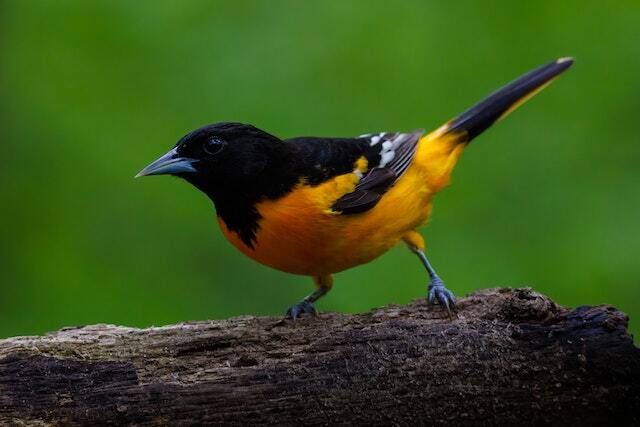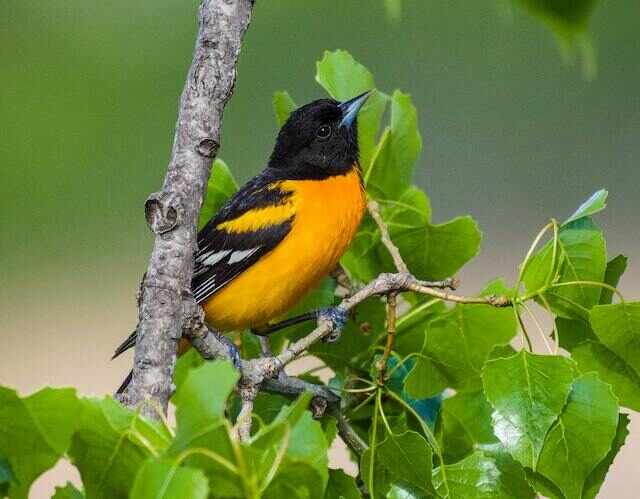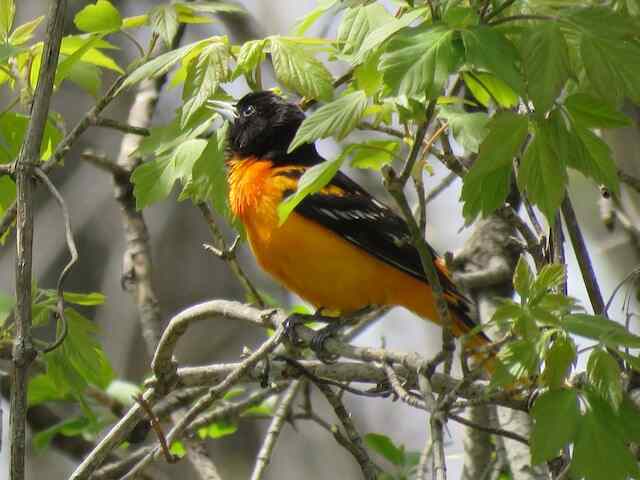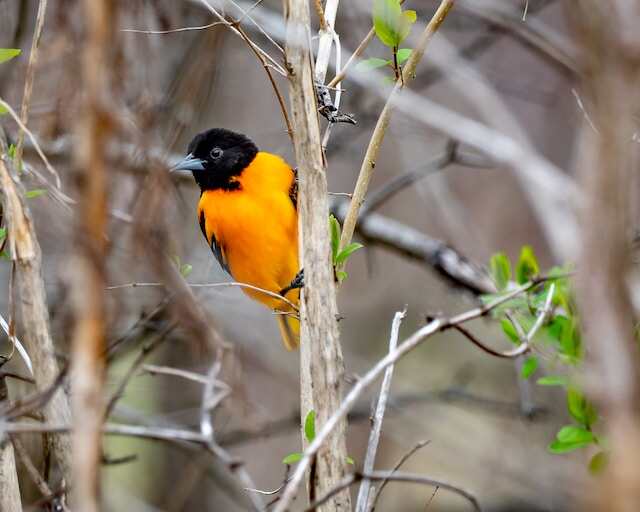Do Baltimore Orioles eat vegetables? That’s the burning question that has intrigued bird enthusiasts and green-thumbed gardeners alike.
These delightful creatures, with their vibrant orange and black plumage, are known for their insectivorous preferences. But what about veggies?
In this article, we’ll unveil the secrets of the Baltimore Orioles’ dietary habits, uncovering whether they indulge in a leafy green treat or stick strictly to their insect-filled feasts.
Get ready to soar through the fascinating world of these avian connoisseurs as we uncover the truth about their culinary adventures. So, grab your binoculars and let’s embark on this culinary safari!
Table of Contents
- 1 Overview of Baltimore Orioles’ Diet
- 2 Do Baltimore Orioles Eat Vegetables?
- 3 Importance of a Balanced Diet
- 4 Types of Vegetables Baltimore Orioles Eat
- 5 Nutritional Benefits of Vegetables
- 6 How Baltimore Orioles Incorporate Vegetables into Their Diet
- 7 Other Foods in Their Diet
- 8 Seasonal Changes in Their Diet
- 9 Conclusion: The Importance of Providing a Varied Diet for Baltimore Orioles
- 10 Frequently Asked Questions
- 10.1 What is the average lifespan of a Baltimore Oriole in the wild?
- 10.2 How do Baltimore Orioles communicate with each other during feeding?
- 10.3 What is the significance of Baltimore Orioles in the ecosystem?
- 10.4 How do Baltimore Orioles defend themselves against predators?
- 10.5 What are the different types of nests Baltimore Orioles build, and how do they choose their nesting spots?
- 11 Overall Conclusion
- 12 Author
Overview of Baltimore Orioles’ Diet
The diet of Baltimore Orioles consists of a diverse range of food sources that include both plant and animal matter.
These birds are known for their bright orange plumage and their migratory patterns, which take them from their breeding grounds in North America to their wintering grounds in Central and South America.
During their migration, Baltimore Orioles rely heavily on nectar from flowers to fuel their flights, but they also consume insects, fruits, and berries.
In their breeding habitats, Baltimore Orioles feed on insects such as ants, caterpillars and beetles, as well as spiders and other arthropods. They also eat fruit, including oranges, grapes, and berries.
If you want to attract Baltimore Orioles to your garden, you can plant native fruit trees and shrubs such as serviceberry, elderberry, strawberry and black cherry, and set up feeders with sugar water or jelly.
A balanced diet is important for these birds to maintain their health and energy levels, as well as to support their reproductive success.

Do Baltimore Orioles Eat Vegetables?
Baltimore Orioles primarily feed on insects, fruits, and nectar, making them omnivorous. While they may not commonly consume vegetables, their diet can vary based on food availability. Their preference for insects and fruits makes up a significant portion of their nutrition.
Importance of a Balanced Diet
Maintaining a well-rounded nutritional intake is critical for ensuring optimal health and vitality.
A balanced diet provides a variety of essential nutrients, including carbohydrates, proteins, fats, vitamins, and minerals, which are necessary for maintaining a healthy body and mind.
Eating a balanced diet has numerous health benefits, such as reducing the risk of chronic diseases, improving brain function and mood, increasing energy levels, and promoting healthy weight management.
However, a lack of a balanced diet can lead to potential risks, including malnutrition, weakened immune system, and increased risk of chronic diseases.
Nutrition and exercise work synergistically for a healthy lifestyle, and a balanced diet can support an active lifestyle by providing the necessary fuel for physical activity.
It is essential to make healthy food choices and incorporate different types of food groups into daily meals to ensure a well-rounded nutritional intake.
With this in mind, let’s explore the types of vegetables Baltimore Orioles eat.
Types of Vegetables Baltimore Orioles Eat
Exploring the diverse range of nutrient-dense vegetables consumed by these majestic birds can evoke a sense of wonder and appreciation for the intricate balance of nature.
Baltimore Orioles are known to consume a variety of vegetables, including leafy greens, carrots, peas, and sweet potatoes.
These vegetables provide a range of benefits, including vitamins, minerals, and fiber, which are essential for maintaining a healthy diet.
The impact of diet on bird behavior is significant, and a balanced diet that includes vegetables can improve their overall health and well-being.
Incorporating vegetables into their diet can also enhance their natural colors and improve their ability to fly and forage for food.
The following table highlights some of the vegetables commonly consumed by Baltimore Orioles and their nutritional benefits:
| Vegetable | Nutritional Benefits |
|---|---|
| Leafy Greens | High in vitamins A, C, and K, and iron |
| Carrots | Rich in beta-carotene, which supports eye health |
| Peas | Good source of protein and fiber |
| Sweet Potatoes | High in vitamin A and potassium |
As we delve deeper into the nutritional benefits of vegetables, it becomes clear that they play a crucial role in maintaining the health and well-being of these beautiful birds.

Nutritional Benefits of Vegetables
The nutritional benefits of vegetables are significant for the overall health and well-being of birds, with leafy greens providing high levels of essential vitamins such as A, C, and K, and iron, which are necessary for proper nutrition and physical development.
Vegetable sources for birds include kale, spinach, broccoli, and carrots, among others. These vegetables are not only rich in vitamins and minerals, but also in fiber, which aids in digestion and promotes healthy gut bacteria.
In terms of vegetable preparation, it is important to avoid cooking vegetables in oil or seasoning them with salt, as this can be detrimental to a bird’s health. Instead, vegetables should be lightly steamed or served raw.
Incorporating a variety of vegetables into a bird’s diet can improve their overall health and reduce the risk of certain diseases.
Understanding how Baltimore Orioles incorporate vegetables into their diet can provide insight into the practical application of these nutritional benefits.
How Baltimore Orioles Incorporate Vegetables into Their Diet
Understanding the incorporation of vegetables into the diet of a commonly observed bird species can provide valuable insights into the practical implementation of the nutritional benefits of vegetables.
Baltimore Orioles, known for their bright orange feathers, are primarily insectivores, but they also consume fruits, nectar, and occasionally vegetables.
Leafy greens such as kale, spinach, and collard greens are among the best vegetables for Baltimore Orioles because they are high in fiber, vitamins, and minerals.
Orioles may also eat other types of vegetables, such as peas and corn, but these should be given in moderation to avoid disrupting their natural diet.
Incorporating vegetables into the diet of Baltimore Orioles is not only beneficial for their health but also promotes biodiversity in the ecosystem.
In the subsequent section about other foods in their diet, we will explore their preferences for fruits, insects, and other sources of nutrition.

Other Foods in Their Diet
In addition to incorporating vegetables into their diet, Baltimore orioles also consume insects and fruits.
Insects provide a valuable source of protein and other nutrients, while fruits offer a sweet and nutritious snack.
By diversifying their diet in this way, Baltimore orioles are able to obtain a wide range of essential nutrients that support their health and wellbeing.
Insects
The insect diet of Baltimore Orioles is a vital component of their foraging habits, serving as the foundation for their avian nutrition pyramid.
Insect protein provides the necessary amino acids and nutrients for growth and development, while the dietary diversity of insects ensures that orioles receive a wide range of vitamins and minerals.
From beetles and caterpillars to spiders and grasshoppers, orioles are adept at catching and consuming a variety of insects.
This diet not only fuels their energy needs, but also aids in digestion and immune function.
As we transition to the subsequent section about fruits, it is important to note that while fruits are a significant part of the oriole’s diet, they rely heavily on insects for their overall health and well-being.
Fruits
Fruits are a crucial component of the Baltimore oriole’s diet, providing essential carbohydrates, fiber, and micronutrients necessary for their daily energy requirements and overall health.
While insects make up the majority of their diet, fruits are a valuable addition, especially during migration periods.
Baltimore Orioles have been observed to have a preference for certain fruits such as oranges, grape jelly, and mealworms.
These fruits provide a quick source of energy for the birds during their long journey. However, fruit preferences can vary depending on the location and availability.
Additionally, the impact of fruit consumption on migration is not fully understood and requires further research.
As the Baltimore oriole’s diet changes with seasonal shifts, it is important to examine how fruit consumption fits into their broader dietary patterns.
Seasonal Changes in Their Diet
The dietary habits of Baltimore Orioles undergo significant changes in response to seasonal variations, potentially enhancing their adaptability and survival strategies.
During the breeding season, Baltimore Orioles primarily feed on insects and caterpillars due to their high protein content, which is essential for the growth and development of their young.
As the breeding season comes to an end, the orioles start to shift their diet towards fruits and nectar, which are abundant during the fall migration period.
During this time, the orioles also rely on the energy-rich sap of trees, such as maple and birch, to fuel their long-distance journeys.
During the winter months, when insects and fruit are scarce, the orioles rely on alternative food sources, such as suet and jelly, that are provided by bird feeders.
It is important to note that these seasonal changes in diet are influenced by migration patterns and environmental factors, such as temperature and precipitation.
Providing a varied diet for Baltimore Orioles throughout the year can enhance their overall health and survival, ultimately contributing to the conservation efforts for this species.
- As we learn about the orioles’ diverse diet, we can appreciate their adaptability to changing environments.
- Understanding the orioles’ seasonal shifts in diet can highlight the importance of conserving natural habitats and resources.
- The orioles’ reliance on alternative food sources provided by humans demonstrates the potential for mutually beneficial relationships between wildlife and humans.
- By appreciating the orioles’ dietary habits, we can deepen our connection to nature and its intricate web of life.
In conclusion, the importance of providing a varied diet for Baltimore Orioles is essential for their survival and adaptability to changing environments.
As we strive to conserve this species, understanding their dietary habits can inform our conservation efforts and deepen our appreciation for the intricate connections between wildlife and their habitats.

Conclusion: The Importance of Providing a Varied Diet for Baltimore Orioles
Understanding the diverse dietary needs of Baltimore orioles and the importance of providing a varied diet can contribute to the overall conservation efforts for this species and promote a deeper appreciation for the intricate connections between wildlife and their environments.
While Baltimore orioles primarily feed on insects during nesting season, they also consume fruits, nectar, and even some vegetables during migration and winter months.
Providing a diverse range of food sources not only helps ensure that the birds receive adequate nutrition, but also supports their overall health and well-being.
Additionally, the role of the environment cannot be ignored, as changes in climate and habitat can impact the availability of food sources for Baltimore orioles.
By understanding the benefits of variety and the role of the environment, we can work towards creating more sustainable and supportive ecosystems for these beautiful birds.
Frequently Asked Questions
What is the average lifespan of a Baltimore Oriole in the wild?
The average lifespan of a Baltimore Oriole in the wild is approximately 8 years.
These birds are migratory, traveling south to Central America and the northern regions of South America during the winter months.
During their breeding season, Baltimore Orioles feed primarily on insects, including caterpillars, spiders, and beetles.
They are also known to consume nectar and fruits, such as oranges, grape jelly, and berries.
However, it is important to note that Baltimore Orioles are not known to consume vegetables as a part of their natural feeding habits.
Understanding the migration and feeding habits of these birds is important for conservation efforts and maintaining biodiversity in their habitats.
How do Baltimore Orioles communicate with each other during feeding?
Baltimore Orioles are known for their unique feeding behaviors, which involve the use of vocal cues and flock dynamics to communicate with each other during foraging.
These birds have specific fruit preferences and are known to migrate annually to different regions.
During feeding, they use various vocalizations to coordinate movements and signal the presence of food. Their flock dynamics involve leadership roles and social hierarchies that affect their feeding habits.
Overall, the feeding behavior of Baltimore Orioles is a fascinating area of study that sheds light on the complex social interactions and ecological roles of these birds.
What is the significance of Baltimore Orioles in the ecosystem?
Baltimore Orioles are significant in the ecosystem as they play a crucial role in pollination. They feed on nectar and fruit, and in the process, transfer pollen from one plant to another, aiding in reproduction.
Additionally, the Baltimore Oriole migration is a fascinating phenomenon, with these birds traveling thousands of miles each year from their breeding grounds in North America to their wintering grounds in Central and South America.
This migration is important not only for the survival of the birds but also for the health of the ecosystems they visit as they help in pollination and seed dispersal.
Therefore, the Baltimore Oriole serves as an important indicator of the health of the ecosystem and highlights the importance of protecting natural habitats for the survival of these valuable pollinators.
How do Baltimore Orioles defend themselves against predators?
Baltimore Orioles have evolved several mechanisms to defend themselves against predators. Predator evasion is a primary defense mechanism employed by these birds. They have the ability to fly at great speeds, making it difficult for predators to catch them.
Orioles also have excellent eyesight, allowing them to spot predators from a distance and react accordingly. In terms of dietary preferences, Baltimore Orioles primarily feed on insects, nectar, and fruits. They are not known to eat vegetables.
Overall, Baltimore Orioles have adapted well to their environment and employ a range of defensive strategies to survive.
What are the different types of nests Baltimore Orioles build, and how do they choose their nesting spots?
Baltimore Orioles are known for their beautiful and intricately woven nests. These nests are made using various materials such as plant fibers, grasses, and hair.
Baltimore Oriole Nesting: Materials & Techniques are chosen based on their ability to withstand harsh weather conditions.
These birds build their nests in trees, typically in the branches of deciduous trees. They choose their nesting spots carefully, often selecting a location that is hidden from predators.
Nesting Behavior & Patterns may vary depending on the location, but generally, these birds lay 4-5 eggs per clutch and incubate them for about two weeks.
Once the chicks hatch, both parents take turns feeding them a diet consisting mainly of insects.
What Do Baltimore Orioles Eat: Diet & Feeding Habits, Impact on Local Flora & Fauna, suggests that while these birds primarily feed on insects, they also consume nectar, fruits, and occasionally, small vertebrates.
Baltimore Orioles’ diet and feeding habits, therefore, have a significant impact on local flora and fauna, making them important contributors to the ecosystem.
Overall, the Baltimore Oriole’s unique nesting behavior, coupled with their diverse feeding habits, make them a fascinating species to study and appreciate.

Overall Conclusion
In conclusion, the Baltimore Oriole’s diet is a balanced mix of insects, fruits, and vegetables. The inclusion of vegetables like kale, spinach, and broccoli not only adds variety but also provides essential nutrients and antioxidants.
These vegetables aid in maintaining the bird’s health and well-being, allowing them to thrive in their habitat and complete their migration successfully.
Just as a varied diet is crucial to the Baltimore Oriole’s survival, so is it for all living beings. Incorporating different foods into our diets provides a range of nutrients that are essential for our overall health.
So, let us learn from these magnificent birds and embrace the diversity of nature’s bounty to achieve a healthy and fulfilling life.



